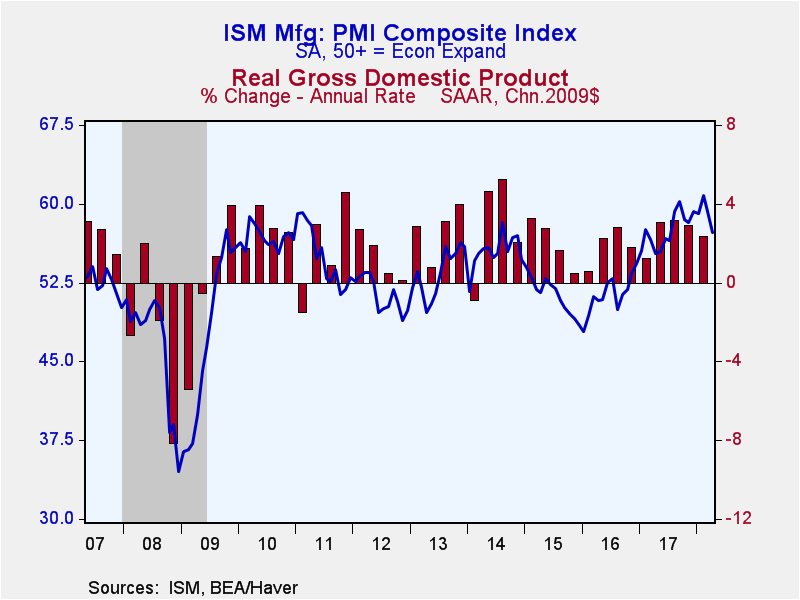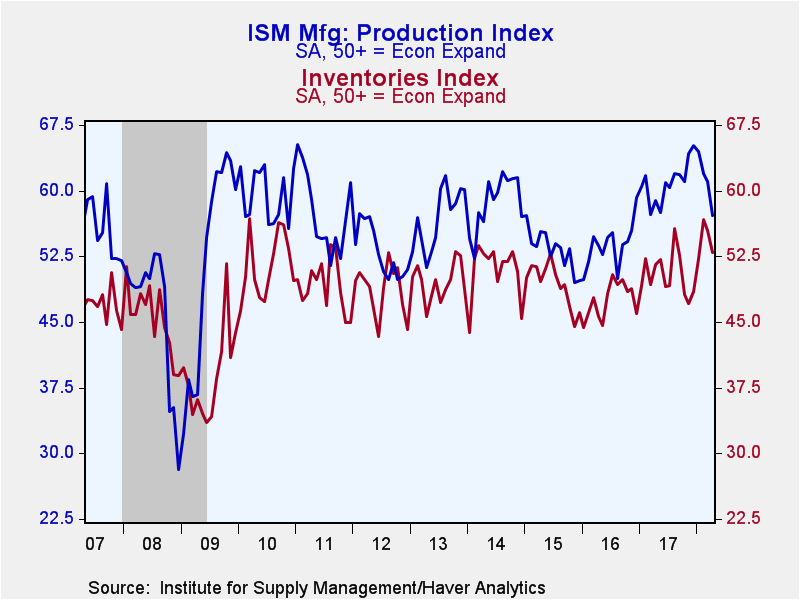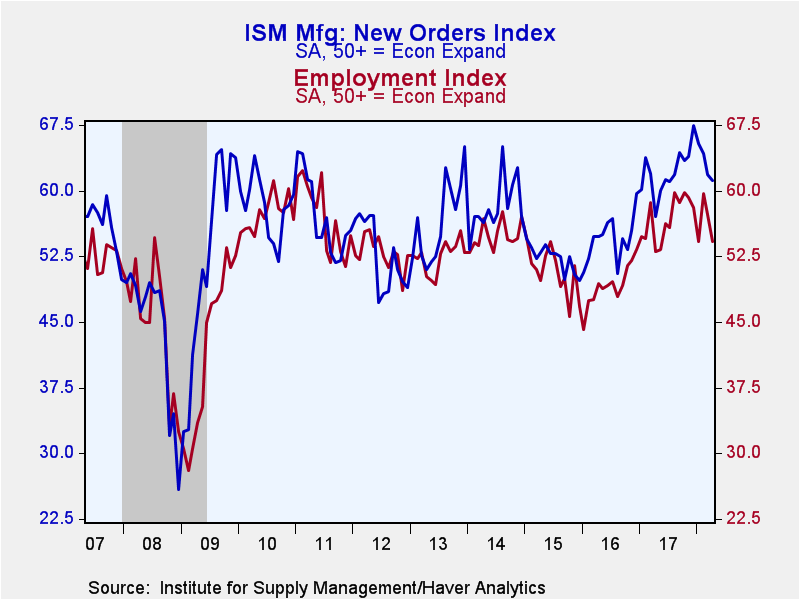 Global| May 01 2018
Global| May 01 2018ISM Factory Sector Index Falls Further; Prices Strengthen
by:Tom Moeller
|in:Economy in Brief
Summary
Activity in the factory sector moderated again last month. The ISM manufacturing sector composite index for April declined to 57.3, its lowest level in nine months. Despite the decline, the index remained near the highest point since [...]
Activity in the factory sector moderated again last month. The ISM manufacturing sector composite index for April declined to 57.3, its lowest level in nine months. Despite the decline, the index remained near the highest point since May 2004. A level of 58.5 had been expected in the Action Economics Forecast Survey. During the last ten years, there has been a 76% correlation between the level of the index and q/q growth in real GDP.
Most of the component series fell last month, led by a decline in the production index to the lowest level since November 2016. The inventories series also declined and was down sharply from the February high. The new orders reading eased modestly following three months of significant decline. The supplier delivery index rose modestly.
The employment figure declined sharply to the lowest point in three months. A stable 23% (NSA) of respondents reported higher employment while a steady 10% indicated a decline. During the last ten years, there has been an 87% correlation between the index and the m/m change in factory sector employment.
The prices paid index strengthened to 79.3. It was the highest level since April 2011 and up from the 2016 low of 33.5. A strengthened 61% percent (NSA) of respondents reported paying higher prices while three percent paid less.
Amongst the separate series measured by the ISM, the export order index fell to the lowest level since December. It remained up sharply, however, from the 2015 low. The import order index also eased to the lowest point since December, but remained up sharply from the 2015 low as well. The order backlog series remained strong at the highest level since May 2004.
The ISM figures are diffusion indexes where a reading above 50 indicates increase. The figures from the Institute for Supply Management can be found in Haver's USECON database. The expectations number is available in Haver's AS1REPNA database.
| ISM Mfg (SA) | Apr | Mar | Feb | Apr'17 | 2017 | 2016 | 2015 |
|---|---|---|---|---|---|---|---|
| Composite Index | 57.3 | 59.3 | 60.8 | 55.3 | 57.4 | 51.4 | 51.3 |
| New Orders | 61.2 | 61.9 | 64.2 | 57.1 | 62.2 | 54.5 | 52.3 |
| Production | 57.2 | 61.0 | 62.0 | 58.9 | 61.0 | 53.8 | 59.3 |
| Employment | 54.2 | 57.3 | 59.7 | 53.0 | 56.8 | 49.2 | 50.7 |
| Supplier Deliveries | 61.1 | 60.6 | 61.1 | 55.9 | 56.8 | 51.8 | 50.8 |
| Inventories | 52.9 | 55.5 | 56.7 | 51.6 | 50.2 | 47.2 | 49.0 |
| Prices Paid Index (NSA) | 79.3 | 78.1 | 74.2 | 68.3 | 65.7 | 53.5 | 39.8 |
Tom Moeller
AuthorMore in Author Profile »Prior to joining Haver Analytics in 2000, Mr. Moeller worked as the Economist at Chancellor Capital Management from 1985 to 1999. There, he developed comprehensive economic forecasts and interpreted economic data for equity and fixed income portfolio managers. Also at Chancellor, Mr. Moeller worked as an equity analyst and was responsible for researching and rating companies in the economically sensitive automobile and housing industries for investment in Chancellor’s equity portfolio. Prior to joining Chancellor, Mr. Moeller was an Economist at Citibank from 1979 to 1984. He also analyzed pricing behavior in the metals industry for the Council on Wage and Price Stability in Washington, D.C. In 1999, Mr. Moeller received the award for most accurate forecast from the Forecasters' Club of New York. From 1990 to 1992 he was President of the New York Association for Business Economists. Mr. Moeller earned an M.B.A. in Finance from Fordham University, where he graduated in 1987. He holds a Bachelor of Arts in Economics from George Washington University.










